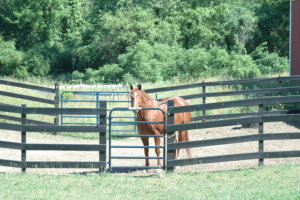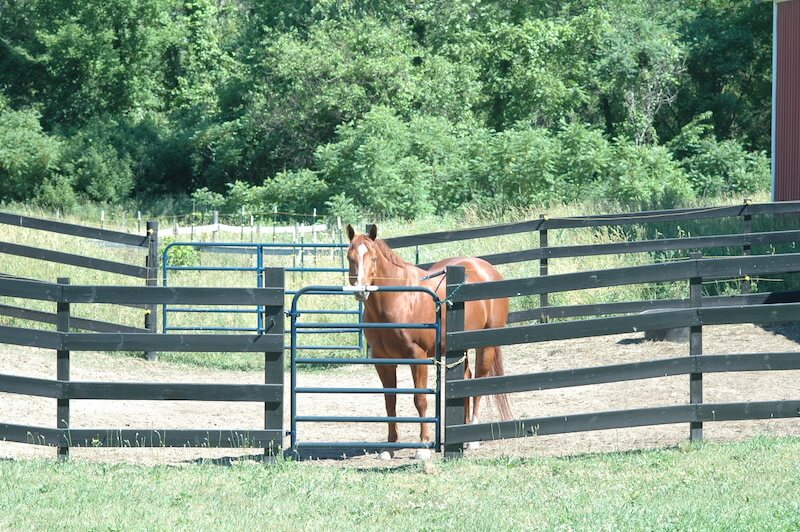Protect Grazing Areas Year-round
by Laurie Cerny

After the drought of 2012 even horse owners who faithfully practice good pasture management are going to do everything in their power to keep their grazing areas as healthy as possible. The advantage of doing so is two-fold: having a healthy pasture helps to reduce the amount of hay you have to feed; grazing is also beneficial to the health and well being of most horses. There are several ways to keep your pastures healthy this summer.
Establish dry lots or “sacrifice areas” for your horses. These pens are the best way to have ultimate control over your grazing schedule. Horses can be held in these pens until pastures have adequate growth for healthy grazing. They are also a place to keep your horses when spring grass is too lush for safe, all-day grazing – especially for horses prone to laminitis and those who are insulin resistant. These pens are also useful after a heavy rain. Using a dry lot until fields have dried out reduces the damage that can occur when horses run around on rain-soaked pastures.
Harrow and fertilize pastures. You want to break up manure piles on a regular basis as a way of adding nutrients to the soil, and also to dry out these areas as a means to breaking parasitic cycles. Pastures should be fertilized at least once a year either with composted manure or a chemical fertilizer. Be careful when using manure. When it’s not fully composted you may also be spreading seeds of undesirable grasses and weeds in hay that was fed over the winter. With commercial fertilizer you should test the soil first. The right levels of nitrogen, phosphorus, and potassium is important. You also want to make sure it’s applied properly, otherwise you could burn new pasture growth.
Don’t put horses out too soon on pastures. You should have at least six inches of growth before horses are turned out for grazing. Likewise, you never want to overgraze. Horses should be taken off fields when growth is no less than three inches. Another rule to follow is this: when you start to see manure piles it’s time to give the field a rest. Mow fields several times throughout the growing season. Mowing not only helps to promote even growth, it’s also a useful tool in weed control (if you mow prior to when weeds have produced seeds you help to prevent reseeding and spreading of the species). Be careful about mowing just prior to a long, dry spell. In particular you want to adjust your mower deck to keep at least two inches of old growth. Mowing fields extremely short before a dry period or during a drought can do permanent damage.
Be diligent about weed control. Weeds can quickly overtake a pasture and reduce the amount of healthy forage for your horses. Familiarize yourself with the problematic weeds in your area and their growth and reproduction cycles. Some weeds can be eradicated by digging; others by mowing before they seed. Extremely invasive species require spraying with an herbicide. To encourage more grass over-seed damaged or bare spots. This can be done anytime throughout the growing season, but is easiest to do in early spring and late fall. If large areas are involved, fall (after you’ve pulled your horses off of the field for the winter) is the better time because you won’t have horses trampling the new growth.
Section large pastures into smaller fields that can be rotated. Rotation is the best way to always have healthy pastures for your horses to graze. Two fields are good; three are even better. Rotate from one field to the next every 5-6 weeks. This way the non-grazed field has several weeks of rest and re-growth. Mowing these fields and harrowing prior to resting is also a good idea. Monitor pastures on a regular basis for growth, weeds and other problems. Pastures should be walked at least 3-4 times a year. Doing so is a great way to assess the state of your fields – including fencing, weeds, overgrazed areas, animal holes or dens, and garbage that may have been thrown into your field (especially if it is located next to a road).
Published May 2013 Issue

The Northwest Horse Source is an independently owned and operated print and online magazine for horse owners and enthusiasts of all breeds and disciplines in the Pacific Northwest. Our contemporary editorial columns are predominantly written by experts in the region, covering the care, training, keeping and enjoyment of horses, with an eye to the specific concerns in our region.






